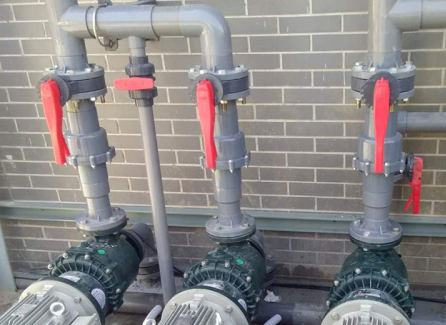Water pump requirements for suction pipes
The requirements of the water pump for the suction pipeline are mainly concentrated in the following aspects to ensure that the water pump can operate efficiently and stably:
1. Basic performance requirements
No air leakage:
Importance: Leakage in the suction pipeline will reduce the water output of the water pump, or even make it impossible to absorb water.
Measures: The pipe must be tight, usually steel pipes, and asphalt anti-corrosion layer is applied when buried in the soil. The joints must be tightly connected to prevent gas leakage.
No air accumulation:
Importance: Air accumulation will form air bags, affecting the water flow capacity and destroying the water suction vacuum.
Measures: The suction pipe should have a continuous upward slope along the water flow direction (generally greater than 0.005) to avoid the formation of air bags. At the same time, the highest point of the suction pipe should be at the top of the water pump suction port, and sharp bends and contractions should be avoided on the suction pipe to reduce the possibility of vortex and air accumulation.
No air suction:
Importance: When the suction pipe inlet is not submerged deep enough, air will be sucked in, affecting the normal operation of the water pump.
Measures: The submerged depth of the suction pipe inlet at the lowest water level should be no less than 0.5~1.0 meters to prevent vortexes from being generated at the inlet and air from being sucked in. In addition, the suction pipe inlet should not be directly connected to the elbow, and a straight pipe section should be installed between the two.
2. Pipe material and pipe diameter selection
Pipe material selection:
Optional materials: PVC pipe, stainless steel pipe, fiberglass pipe, etc. PVC pipe is commonly used because of its corrosion resistance, wear resistance, high temperature resistance and relatively low price. Stainless steel pipe and fiberglass pipe have stronger corrosion resistance and longer service life.
Notes: The pipe must meet the sealing requirements, and corrosion resistance, wear resistance and pressure bearing capacity must be considered.
Pipe diameter selection:
Principle: The diameter of the suction pipe should be larger than the inner diameter of the water pump inlet to reduce friction loss in fluid movement and improve water pump efficiency.
Flow rate control: According to the different pipe diameters, the flow rate should be controlled within a certain range (e.g., when the diameter is less than 250mm, the flow rate should be 1.0~1.2m/s; when the diameter is 250~1000mm, it should be 1.2~1.6m/s, etc.).
III. Layout and installation requirements
Layout design:
Try to shorten the length of the suction pipe to reduce pipe resistance and head loss.
Ensure that the suction pipe has no bends, shrinkage, or air leakage to avoid affecting the water absorption effect.
In the case of non-self-priming water filling, in order to prevent air from accumulating in the pipe, the horizontal section of the suction pipe should have a slope rising toward the water pump.
Installation requirements:
A filter or grille should be installed at the inlet of the suction pipe to prevent debris in the water from entering the water pump.
When the highest design water level of the suction pool (well) is higher than the water pump, a pressure vacuum gauge and a check valve should be installed on the suction pipe; when the highest design water level is lower than the water pump, a vacuum gauge should be installed for monitoring.
In some cases (such as when the water level in the suction tank is higher than the pump axis), a gate valve should be installed on the suction pipe to facilitate pump maintenance.

4. Other precautions
When the water contains large suspended impurities, a filter should be added at the inlet of the suction pipe to prevent debris from entering the pump.
Regularly check and maintain the suction pipe and its accessories (such as bottom valves, filters, etc.) to ensure that they are in good condition and meet operating requirements.




